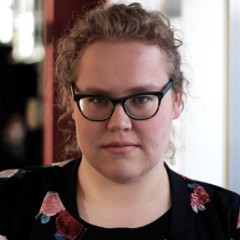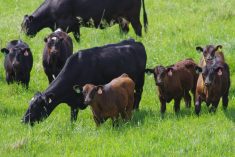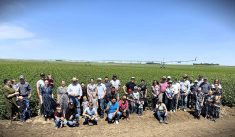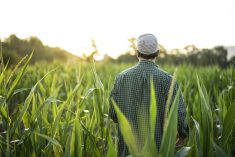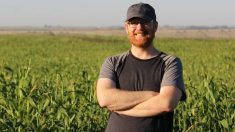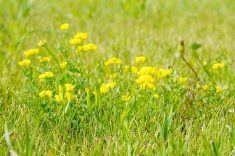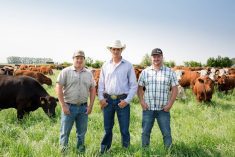Glacier FarmMedia – A carbon offset program could boost adoption of regenerative farming but it can’t use cookie-cutter protocols, says the head of an Alberta organization that promotes the practice.
“To try to standardize something that is fundamentally adaptive and site specific, and also based on a lot of innovation, it’s going to put a cap on the innovation that can happen,” Kimberly Cornish, founder of Olds-based Food Water Wellness Foundation, said at a recent regenerative ag conference here.
“There are all these amazing outcomes of regenerative agriculture, and we know that we’re sequestering carbon in the soil because we know the organic matter is going up.”
Read Also

Grazing ‘sweet spot’ boosts pasture performance
Timing-focused approach to pasture management touted to boost forage growth, livestock gains while also cutting farmer labour and inputs
While adoption of regenerative ag practices is increasing, it’s “not at the rate that I think a lot of us who work in this space expected it to,” Cornish said.
Paying farmers for increasing soil carbon storage would be an incentive, but existing offset programs aren’t well suited to those farming practices, she said.
She cited the Alberta government’s carbon offset market which includes a conservation cropping protocol that allowed farmers to generate carbon credits. (The program ends at the end of this year.) The province was split into two regions, and what farmers were paid was based on projections of how much carbon certain practices could sequester.
“There is no mechanism to quantify whether or not you were sequestering any carbon,” said Cornish. “It just mattered that you had the equipment and you followed the protocol.”
That’s “problematic” in regenerative ag because its practices for boosting soil health and the ecosystem are farm specific. Producers also wanted to be paid for what they actually sequestered on their own land, he said.
“There’s a potential for a considerable amount of money to be made, but it needs to be done in a specific way that the value rests with the land managers as a motivation to either continue managing this way, or start managing this way,” Cornish said.
She pointed to the work of Alex McBratney, an Australian scientist who co-developed a farm-scale soil carbon auditing method that maps soil carbon over a given area. Food Water Wellness is currently running a pilot project (funded by the Canadian Agricultural Partnership) to measure soil carbon.
Counterintuitively, said Cornish, the simplest way to measure carbon on a farm scale was to map the whole province of Alberta, and then zoom in on a farm. The map combined layers of data and soil tests from as many eco-regions as possible.
The resulting map shows a snapshot of soil carbon levels across Alberta from the topsoil to 100 centimetres depth. From there, they could zoom in to an individual farm.
In her presentation Cornish showed Shipwheel Cattle Feeders, a Taber operation that has a 5,500-head feedlot, crops, bees, and pastured poultry and has long practised rotational grazing.
Cornish compared soil carbon on nearby cropland and Shipwheel’s multi-paddock grazing land. The cropland contained about 26.9 tonnes per acre of soil carbon, while the grazing land had 39.6 tonnes per acre. That’s 12.7 tonnes per acre more, or nearly 47 tonnes of CO2 equivalent per acre, which is “pretty considerable,” Cornish said.
A foundation team will repeat the mapping process in 2022 to measure the change in soil carbon, and will repeat the process again after that.
While focusing on how to measure sequestered carbon, Food Water Wellness is also considering how best to sell credits and reward farmers.
Cornish said what they heard from producers is that they didn’t want to be locked into a long-term conservation easement. They wanted the flexibility to sell their land and to not tie the hands of the next generation.
The foundation is considering a model in which revenue from credits would be secured in a fund to ensure permanence, and to index against the future value of carbon going up. An annual payment from that fund would be paid to the farmer in perpetuity. This would incentivize farmers to keep the carbon stored or add more, Cornish said.
The program would begin by generating credits based on avoided conversion of pasture or grassland to cropland.
Some people are skeptical about these types of credits because they’re “just keeping a ranch, a ranch,” said Cornish, but said with the high price of canola, “anything that can be cropped is getting ripped up.” Carbon mapping can show how much carbon could be lost if the grass was replaced by crops.
And there’s a market for real carbon credits, she said.
“I feel like every day there’s a new company — a private company that makes the declaration that it’s going to be net zero by 2040 or 2050 and there’s really no way it’s going to do that, at least in the short term, without some degree of offsetting,” she said.
“Our goal is to see regenerative agriculture scaled, not to provide carbon offsets. And we think carbon offsets are a means to being able to do that.”
– Geralyn Wichers is a reporter for the Manitoba Co-operator. Her article appeared in the Dec. 2, 2021 issue.

